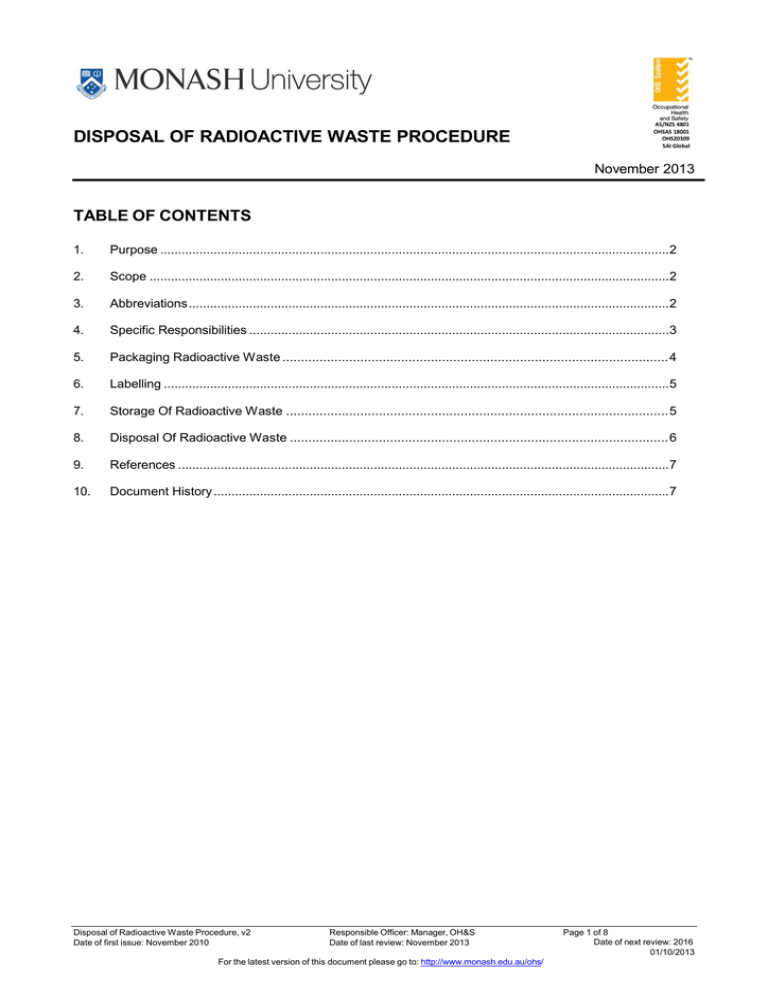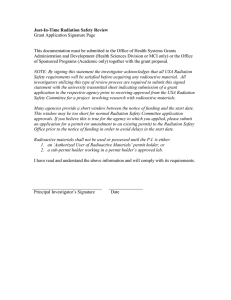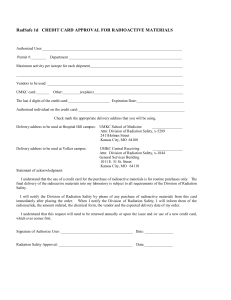DISPOSAL OF RADIOACTIVE WASTE PROCEDURE TABLE OF CONTENTS November 2013
advertisement

DISPOSAL OF RADIOACTIVE WASTE PROCEDURE AS/NZS 4801 OHSAS 18001 OHS20309 SAI Global November 2013 TABLE OF CONTENTS 1. Purpose ............................................................................................................................................... 2 2. Scope .................................................................................................................................................. 2 3. Abbreviations ....................................................................................................................................... 2 4. Specific Responsibilities ...................................................................................................................... 3 5. Packaging Radioactive Waste ........................................................................................................ 4 6. Labelling .............................................................................................................................................. 5 7. Storage Of Radioactive Waste ....................................................................................................... 5 8. Disposal Of Radioactive Waste ...................................................................................................... 6 9. References .......................................................................................................................................... 7 10. Document History ................................................................................................................................ 7 Disposal of Radioactive Waste Procedure, v2 Date of first issue: November 2010 Responsible Officer: Manager, OH&S Date of last review: November 2013 For the latest version of this document please go to: http://www.monash.edu.au/ohs/ Page 1 of 8 Date of next review: 2016 01/10/2013 1. PURPOSE This procedure sets out the requirements for the correct packaging and disposal of radioactive waste by any staff member or student who generates radioactive waste whilst working or studying with radioactive material at Monash University, in accordance with the Radiation Act 2005, Radiation Regulations 2007 and the Occupational Health and Safety Act 2004. 2. SCOPE This procedure applies to staff, students, visitors and contractors at the Australian campuses of Monash University. 3. ABBREVIATIONS Bq Ci OH&S RSO RPO 4. Becquerel Curie Occupational Health and Safety Branch Radiation Safety Officer Radiation Protection Officer DEFINITIONS A comprehensive list of definitions is provided in the Definitions Tool. Definitions specific to this procedure are as follows. 4.1 BECQUEREL The activity of a quantity of radioactive material in which one nucleus decays per second. 4.2 CONTAMINATED LIQUID WASTE Liquid radioactive waste (miscible or immiscible) that contains significant levels of chemical contamination. 4.3 CURIE 10 A non-SI unit of activity. It equates to 3.7 x 10 Bq. 4.4 IMMISCIBLE LIQUID WASTE Liquid radioactive waste that is immiscible with water and therefore not able to go to the sewer at any activity or rate. 4.5 LOW LEVEL SOLID WASTE Comprises solid items such as benchcote, gloves, pipettes and empty scintillation vials. Each package should contain one radionuclide, and the activity in each package must be less than; Radioisotope Activity in a single package less than P-32 0.1 MBq Na-22, I-125 1 MBq C-14, Cr-51 10 MBq P-33, S-35 100 MBq H-3 1 GBq Contact the RPO for information on disposal of other radionuclides Disposal of Radioactive Waste Procedure, v2 Date of first issue: November 2010 Responsible Officer: Manager, OH&S Date of last review: November 2013 For the latest version of this document please go to: http://www.monash.edu.au/ohs/ Page 2 of 8 Date of next review: 2016 01/10/2013 4.6 MEDIUM TERM SOLID WASTE Packages that contain more than the amounts in the table above cannot be disposed of to landfill immediately, and are designated medium term radioactive waste. 4.7 MISCIBLE LIQUID WASTE Liquid radioactive waste that is miscible with water and therefore able to go to sewer. 4.8 OCCUPATIONAL EXPOSURE Occupational exposure is exposure of a person to radiation that occurs in the course of that person’s work or study. 4.9 PUTRESCIBLES WASTE Putrescibles waste is solid waste that contains organic matter capable of being decomposed by microorganisms (e.g. carcasses, tissue samples). 4.10 RADIATION PROTECTION OFFICER The Radiation Protection Officer is the OH&S staff member responsible for providing and coordinating radiation protection services at Monash University. 4.11 RADIATION SAFETY OFFICER A radiation safety officer is a designated staff member in a unit responsible for approving and supervising the ionising radiation work and study of staff and students. 4.12 RADIATION WORKER A radiation worker is a staff member or student who is exposed to ionising radiation as a result of working with ionising radiation source(s) as part of their work/study. 4.13 SHARPS WASTE Sharps waste comprises objects that can pierce or penetrate the skin. 5. SPECIFIC RESPONSIBILITIES A comprehensive list of OHS responsibilities is provided in the document OHS roles, committees and responsibilities procedure. A summary of responsibilities with respect to this procedure is provided below. 5.1 HEAD OF ACADEMIC/ADMINISTRATIVE UNIT The head of academic/administrative unit is responsible for: ensuring compliance of the unit with the radioactive waste disposal procedure; providing budgetary resources to cover the cost of the waste disposal for their unit to be carried out by a government approved waste contractor. 5.2 RADIATION SAFETY OFFICER The RSO is responsible for: providing advice on packaging and storage within their area; ensuring that all radiation workers correctly package and store radioactive waste as per guidelines; maintaining records of the number of bags, pails and sharps containers of each type of solid radioisotope sent for disposal; ensuring suitable storage of immiscible and contaminated liquid waste for the appropriate amount of time; and monitoring the amount of waste generated and disposed via the sewer and maintaining a record of the volume and radioisotopes in each case. Disposal of Radioactive Waste Procedure, v2 Date of first issue: November 2010 Responsible Officer: Manager, OH&S Date of last review: November 2013 For the latest version of this document please go to: http://www.monash.edu.au/ohs/ Page 3 of 8 Date of next review: 2016 01/10/2013 5.3 RADIATION PROTECTION OFFICER The RPO is responsible for: overseeing the compliance of all campuses with the University’s radioactive waste disposal procedure; selecting the external waste contractor; ensuring the implementation of a system for monitoring surface dose rates of each waste package and the clearance of university managed stores by the external contractor 5.4 RADIATION WORKER The radiation worker must follow the radioactive waste disposal procedure as outlined below for the entire period of working with ionising radiation. 6. PACKAGING RADIOACTIVE WASTE Packaging should be undertaken as follows: 6.1 LOW LEVEL SOLID WASTE – GENERAL 6.2 LOW LEVEL SOLID WASTE – SCINTILLATION VIALS 6.3 Pack in disposal pails provided by disposal contractor Single radionuclide per package Activity less than that given in table in 4.8 Surface dose limit less than 5µSvh-1 OR for -emitters 10 cps on GeigerMuller detectors OR for -emitters 100 cps on scintillation detector Do not over-fill If lid does not seal securely, tape with adhesive. NO trefoil tape. No external contamination on pail Label as per section 7 SHARPS 6.4 Pack in a thick paper bag with 100µm polyethylene lining (“wetbag”) Single radionuclide per package Activity less than that given in table in 4.8 Surface dose limit less than; -1 5µSvh on dose rate meter; OR for -emitters: 10 cps on Geiger-Muller detectors; OR for -emitters: 100 cps on scintillation detector. No sealed sources Do not over-fill No external contamination; use plastic overbag if necessary or desired No objects sticking through bag Sealed firmly with adhesive tape. Do not place trefoil tape on the bag. Label as per section 7 Approved plastic sharps container with single piece of trefoil tape around the diameter Activity less than that given in table in 4.8 Surface dose limit less than 5µSvh-1 OR for -emitters 10 cps on GeigerMuller detectors OR for -emitters 100 cps on scintillation detector No external contamination Label as per section 7 PUTRESCIBLES store in freezer until disposal is imminent Disposal of Radioactive Waste Procedure, v2 Date of first issue: November 2010 Responsible Officer: Manager, OH&S Date of last review: November 2013 For the latest version of this document please go to: http://www.monash.edu.au/ohs/ Page 4 of 8 Date of next review: 2016 01/10/2013 7. bag to avoid leakage overbag with wet bag and comply with low level solid waste requirements LABELLING A paper label with the following details should be securely affixed to the external surface of all containers: 8. Academic/Administrative unit name Responsible person Building and room number Phone number Radionuclide Half life Estimated total activity (in MBq) and date Description of physical contents Signature STORAGE OF RADIOACTIVE WASTE 8.1 WASTE STORES Monash University has the following storage areas for low level solid radioactive waste: CLAYTON CAMPUS PARKVILLE CAMPUS Building 4 store ALFRED HOSPITAL Building 23 compound radiation waste store Building 77 radiation waste store Hospital based facility MONASH MEDICAL CENTRE/MHRP - Hospital based facility MHRP Building 2 store Academic/Administrative units may use whichever storage area is practical. For Clayton campus stores, collection of waste from the stores is organised by OH&S and costs charged back to the cost centres generating the waste. In the case of the hospital-based facilities, Monash University uses these by arrangement with the hospital concerned, and users must comply with the hospital’s packaging, storage, recordkeeping and access requirements. 8.2 LOW LEVEL SOLID WASTE (WETBAGS, SCINTILLATION PAILS, SHARPS CONTAINERS) Comply with packaging requirements (Section 6) Place in appropriate campus store, and within the designated area for that radionuclide/package type Disposal of Radioactive Waste Procedure, v2 Date of first issue: November 2010 Responsible Officer: Manager, OH&S Date of last review: November 2013 For the latest version of this document please go to: http://www.monash.edu.au/ohs/ Page 5 of 8 Date of next review: 2016 01/10/2013 8.3 MEDIUM TERM SOLID WASTE Longer-lived isotopes (3H, 14C, 22Na) should not be packaged in amounts greater than that shown in section 4.8, as they will not decay to disposal levels within a reasonable time. Isotopes with shorter half-lives (32P, 33P, 35S, 51Cr, 125I) may be packaged in amounts greater than that in section 4.8 and left for decay if necessary. Appropriate shielded storage for this waste should be made available in the area where it is generated; Packages left for decay should be clearly marked with the estimated date for disposal. 8.4 LIQUID WASTELiquids should be contained in sturdy containers with a long life expectancy (particularly if the liquids are to be kept to decay), which are suitable for transportation if necessary e.g. a disused Winchester. The following general rules apply to choosing a suitable container: Plastics are usually only suitable for use for aqueous liquids. Liquids containing solvents must be stored in glass or metal. Liquids containing corrosives can usually only be stored in certain types of plastics or glass. Liquids must be separated into groups: Miscible with water Immiscible with water Those with significant chemical contamination No solid material (such as scintillation vials or caps) may be placed into a container with liquid waste. The container should be securely labelled with the details given in section 7. 8.5 HAZARDOUS WASTE Production of radioactive waste that also has chemical or biological hazards must be minimised as much as possible; especially in the case of long half-life isotopes. Waste with isotopes with shorter half-lives (32P, 33P, 35S, 51Cr, 125I) may be packaged in accordance with all hazards and left to decay until they are no longer radioactive and then disposed of as chemical or biological waste. Waste with isotopes with longer half-lives (3H, 14C, 22Na) should be treated to neutralise the non-radiation hazard (chemical or biological) and then disposed of as radioactive waste. Waste with isotopes with longer half-lives that have other hazards that cannot be neutralised must be dealt with on a case by case basis. Contact the Radiation Protection Officer to discuss the issue. 9. DISPOSAL OF RADIOACTIVE WASTE 9.1 LOW LEVEL SOLID WASTE Low level solid waste is checked in storage for compliance by the Radiation Protection Officer for Clayton or Radiation Safety Officer for the other campuses and centres and then disposed of to secure landfill via a waste contractor. 9.2 MISCIBLE LIQUID WASTE Miscible liquid waste can be disposed of to sewer so long as it is done in in accordance with the Department of Health guidelines and AS 2243.4. A dedicated sink for disposal of liquid radioactive waste should be made available. The RSO should be involved in selecting this sink and controlling disposal to it. As it is likely to become contaminated, the sink should be flushed copiously with water each time it is used in order to remove residual contamination. Where the liquid is too highly active to be put down the sink in a single aliquot, the disposal needs to be spread over a number of days. Disposal of Radioactive Waste Procedure, v2 Date of first issue: November 2010 Responsible Officer: Manager, OH&S Date of last review: November 2013 For the latest version of this document please go to: http://www.monash.edu.au/ohs/ Page 6 of 8 Date of next review: 2016 01/10/2013 The following amounts of individual water soluble radioisotopes represent the maximum activity that any one unit, at any single Monash campus may place down the sewer in any 24 hour period: Radioisotope Maximum activity to sewer per building per 24 hour period H-3 10MBq 270µCi C-14 10MBq 270µCi Na-22 1MBq 27µCi P-32 1MBq 27µCi P-33 1MBq 27µCi S-35 1MBq 27µCi Cr-51 10MBq 270µCi Zn-65 1MBq 27µCi I-125 0.1MBq 2.7µCi Contact the RPO for information on disposal of other radionuclides 9.3 PUTRESCIBLES Animal carcasses or other putrescible waste that is radioactively contaminated must be stored in a freezer dedicated to radioactive materials until they have decayed to background levels. If decay to background is not practicable, they should be stored in a freezer dedicated to radioactive materials until disposal via landfill is imminent. They should then be bagged (to avoid leakage) and packed as for low level waste in a wet bag. 10. REFERENCES 10.1 LEGISLATION Radiation Act (2005) Radiation Regulations 2007 10.2 CODES OF PRACTICE AND RELATED DOCUMENTS Recommendations for Limiting Exposure to Ionizing Radiation (Printed 1995 Republished 2002) and National Standard for Limiting Occupational Exposure to Ionizing Radiation (Printed 1995 - Republished 2002) Radioactive Material Disposal Requirements, Department of Health 10.3 MONASH UNIVERSITY OHS DOCUMENTS OHS roles, committees and responsibilities procedure Protecting the unborn child from the effects of ionising radiation Using Ionising Radiation at Monash University 10.4 AUSTRALIAN STANDARDS AS 2243.4:1998 Safety in Laboratories Part 4 Ionising radiation Disposal of Radioactive Waste Procedure, v2 Date of first issue: November 2010 Responsible Officer: Manager, OH&S Date of last review: November 2013 For the latest version of this document please go to: http://www.monash.edu.au/ohs/ Page 7 of 8 Date of next review: 2016 01/10/2013 11. DOCUMENT HISTORY Version number Date of first issue Changes made 1 2 November 2010 November 2013 Procedures for disposal of radioactive waste 1. Changed name to “Disposal of Radioactive Waste procedure 2. Section 6 changed to reflect that any colour sticky tape can be used, as long as it is not trefoil tape. 3. Section 6 changed to reflect that “no more than 2/3 full” is overly prescriptive, when the intent is just that it not be over-full. 4. Removal of one definition not specific to this procedure 5. Additions to procedure: - to acknowledge the complications when waste is both radioactive AND another hazard class. - Added section on what to do with radioactive waste with additional hazards. Disposal of Radioactive Waste Procedure, v2 Date of first issue: November 2010 Responsible Officer: Manager, OH&S Date of last review: November 2013 For the latest version of this document please go to: http://www.monash.edu.au/ohs/ Page 8 of 8 Date of next review: 2016 01/10/2013 Disposal of Radioactive Waste Procedure, v2 Date of first issue: November 2010 Responsible Officer: Manager, OH&S Date of last review: November 2013 For the latest version of this document please go to: http://www.monash.edu.au/ohs/ Page 9 of 8 Date of next review: 2016 01/10/2013



